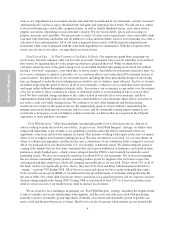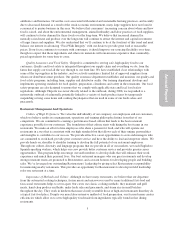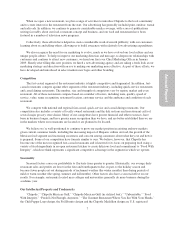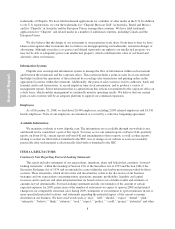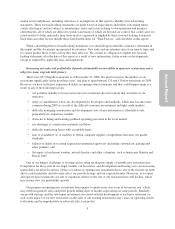Chipotle 2008 Annual Report Download - page 16
Download and view the complete annual report
Please find page 16 of the 2008 Chipotle annual report below. You can navigate through the pages in the report by either clicking on the pages listed below, or by using the keyword search tool below to find specific information within the annual report.
Competition could adversely affect us.
The fast-casual, quick-service and casual dining segments of the restaurant industry are highly competitive
with respect to, among other things, taste, price, food quality and presentation, service, location and the ambience
and condition of each restaurant. Our competition includes a variety of restaurants in each of these segments,
including locally owned restaurants and national and regional chains. Our competitors offer dine-in, carry-out
and delivery services. Many of our competitors have existed longer than we have and often have a more
established market presence with substantially greater financial, marketing, personnel and other resources than
we have. Among our main competitors are a number of multi-unit, multi-market Mexican food or burrito
restaurant concepts, some of which are expanding nationally. As we expand further in existing markets, our
existing restaurants may face competition from our new restaurants that begin operating in those markets.
Several of our competitors compete by offering menu items that are specifically identified as low in
carbohydrates, better for customers or otherwise targeted at particular consumer preferences. Many of our
competitors in the fast-casual and quick-service segments of the restaurant industry also emphasize lower-cost,
“value meal” menu options, a strategy we do not currently pursue. Our sales may be adversely affected by these
products and price competition.
Moreover, new companies may enter our markets and target our customers. For example, additional
competitive pressures have come more recently from the deli sections and in-store cafés of several major grocery
store chains, including those targeted at customers who want higher-quality food, as well as from convenience
stores and casual dining outlets. These competitors may have, among other things, lower operating costs, better
locations, better facilities, better management, more effective marketing and more efficient operations than we
have.
In addition, our strategy includes opening additional restaurants in existing markets. As we open more
restaurants in an existing market, sales may decline in some existing restaurants as customers who frequent one
of our established restaurants may begin to visit one of our new restaurants instead.
Any of these competitive factors may adversely affect us and reduce our sales and profits.
Our insurance coverage and self-insurance reserves may not cover future claims.
We maintain various insurance policies for employee health, worker’s compensation, general liability and
property damage. In conjunction with our separation from McDonald’s, we entered into certain new insurance
policies with modified coverage. Prior to entering into the new policies, we were covered by fixed cost policies
for health insurance and worker’s compensation. We are now self-insured for our health plans, and have
purchased a fully-insured stop loss policy to help offset our liability for both individual and aggregate claim
costs. We are also responsible for losses up to a certain limit for worker’s compensation, general liability and
property damage insurance.
For policies under which we are responsible for losses, we record a liability that represents our estimated
cost of claims incurred and unpaid as of the balance sheet date. Our estimated liability is not discounted and is
based on a number of assumptions and factors, including historical trends, actuarial assumptions and economic
conditions, and is closely monitored and adjusted when warranted by changing circumstances. Our history of
claims experience is short and our significant growth rate could affect the accuracy of estimates based on
historical experience. Should a greater amount of claims occur compared to what was estimated or medical costs
increase beyond what was expected, our accrued liabilities might not be sufficient and we may be required to
record additional expense. Unanticipated changes may produce materially different amounts of expense than that
reported under these programs, which could adversely impact our results of operations.
14
Annual Report


